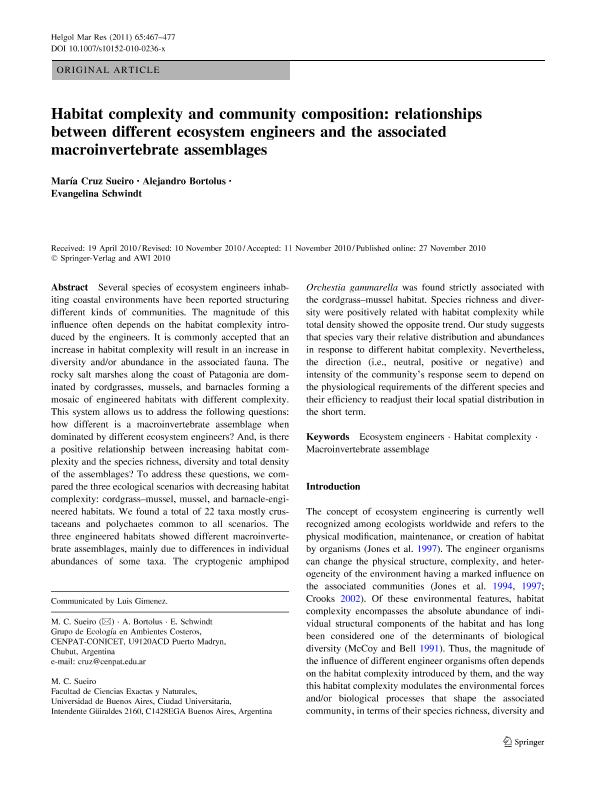Mostrar el registro sencillo del ítem
dc.contributor.author
Sueiro, Maria Cruz

dc.contributor.author
Bortolus, Alejandro

dc.contributor.author
Schwindt, Evangelina

dc.date.available
2019-06-18T22:19:39Z
dc.date.issued
2011-12
dc.identifier.citation
Sueiro, Maria Cruz; Bortolus, Alejandro; Schwindt, Evangelina; Habitat complexity and community composition: relationships between different ecosystem engineers and the associated macroinvertebrate assemblages; Springer Verlag Berlín; Helgoland Marine Research; 65; 4; 12-2011; 467-477
dc.identifier.issn
1438-387X
dc.identifier.uri
http://hdl.handle.net/11336/78513
dc.description.abstract
Several species of ecosystem engineers inhabiting coastal environments have been reported structuring different kinds of communities. The magnitude of this influence often depends on the habitat complexity introduced by the engineers. It is commonly accepted that an increase in habitat complexity will result in an increase in diversity and/or abundance in the associated fauna. The rocky salt marshes along the coast of Patagonia are dominated by cordgrasses, mussels, and barnacles forming a mosaic of engineered habitats with different complexity. This system allows us to address the following questions: how different is a macroinvertebrate assemblage when dominated by different ecosystem engineers? And, is there a positive relationship between increasing habitat complexity and the species richness, diversity and total density of the assemblages? To address these questions, we compared the three ecological scenarios with decreasing habitat complexity: cordgrass–mussel, mussel, and barnacle-engineered habitats. We found a total of 22 taxa mostly crustaceans and polychaetes common to all scenarios. The three engineered habitats showed different macroinvertebrate assemblages, mainly due to differences in individual abundances of some taxa. The cryptogenic amphipod Orchestia gammarella was found strictly associated with the cordgrass–mussel habitat. Species richness and diversity were positively related with habitat complexity while total density showed the opposite trend. Our study suggests that species vary their relative distribution and abundances in response to different habitat complexity. Nevertheless, the direction (i.e., neutral, positive or negative) and intensity of the community’s response seem to depend on the physiological requirements of the different species and their efficiency to readjust their local spatial distribution in the short term.
dc.format
application/pdf
dc.language.iso
eng
dc.publisher
Springer Verlag Berlín

dc.rights
info:eu-repo/semantics/openAccess
dc.rights.uri
https://creativecommons.org/licenses/by/2.5/ar/
dc.subject
Ecosystem Engineers
dc.subject
Habitat Complexity
dc.subject
Macroinvertebrate Assemblage
dc.subject.classification
Otras Ciencias Biológicas

dc.subject.classification
Ciencias Biológicas

dc.subject.classification
CIENCIAS NATURALES Y EXACTAS

dc.title
Habitat complexity and community composition: relationships between different ecosystem engineers and the associated macroinvertebrate assemblages
dc.type
info:eu-repo/semantics/article
dc.type
info:ar-repo/semantics/artículo
dc.type
info:eu-repo/semantics/publishedVersion
dc.date.updated
2019-03-08T16:47:20Z
dc.identifier.eissn
1438-3888
dc.journal.volume
65
dc.journal.number
4
dc.journal.pagination
467-477
dc.journal.pais
Alemania

dc.description.fil
Fil: Sueiro, Maria Cruz. Consejo Nacional de Investigaciones Científicas y Técnicas. Centro Nacional Patagónico; Argentina. Universidad de Buenos Aires. Facultad de Ciencias Exactas y Naturales; Argentina
dc.description.fil
Fil: Bortolus, Alejandro. Consejo Nacional de Investigaciones Científicas y Técnicas. Centro Nacional Patagónico; Argentina
dc.description.fil
Fil: Schwindt, Evangelina. Consejo Nacional de Investigaciones Científicas y Técnicas. Centro Nacional Patagónico; Argentina
dc.journal.title
Helgoland Marine Research

dc.relation.alternativeid
info:eu-repo/semantics/altIdentifier/doi/https://doi.org/10.1007/s10152-010-0236-x
dc.relation.alternativeid
info:eu-repo/semantics/altIdentifier/url/https://link.springer.com/article/10.1007/s10152-010-0236-x
Archivos asociados
